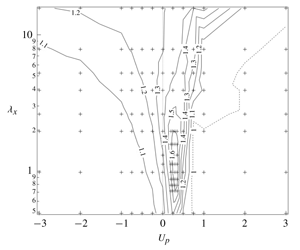Crossref Citations
This article has been cited by the following publications. This list is generated based on data provided by
Crossref.
Hara, Shumpei
Tsukahara, Takahiro
and
Kawaguchi, Yasuo
2020.
Turbulent transport dissimilarity with modulated turbulence structure in channel flow of viscoelastic fluid.
International Journal of Heat and Fluid Flow,
Vol. 86,
Issue. ,
p.
108739.
Brethouwer, Geert
2021.
Much faster heat/mass than momentum transport in rotating Couette flows.
Journal of Fluid Mechanics,
Vol. 912,
Issue. ,
Ryu, Sangjin
Davis, Ethan
Park, Jae Sung
Zhang, Haipeng
and
Yoo, Jung Yul
2021.
Wall-Shear-Stress-Based Conditional Sampling Analysis of Coherent Structures in a Turbulent Boundary Layer.
Journal of Fluids Engineering,
Vol. 143,
Issue. 4,
MAMORI, Hiroya
FUKUDOME, Koji
OGINO, Kohei
FUKUSHIMA, Naoya
and
YAMAMOTO, Makoto
2021.
Heat transfer enhancement and torque reduction by traveling wave-like blowing and suction in turbulent Taylor-Couette flow.
Journal of Thermal Science and Technology,
Vol. 16,
Issue. 1,
p.
JTST0003.
Kuwata, Y.
2021.
Direct numerical simulation of turbulent heat transfer on the Reynolds analogy over irregular rough surfaces.
International Journal of Heat and Fluid Flow,
Vol. 92,
Issue. ,
p.
108859.
Kaithakkal, Arjun J.
Kametani, Yukinori
and
Hasegawa, Yosuke
2021.
Dissimilar heat transfer enhancement in a fully developed laminar channel flow subjected to a traveling wave-like wall blowing and suction.
International Journal of Heat and Mass Transfer,
Vol. 164,
Issue. ,
p.
120485.
Yao, Jie
Chen, Xi
and
Hussain, Fazle
2021.
Composite active drag control in turbulent channel flows.
Physical Review Fluids,
Vol. 6,
Issue. 5,
Yamamoto, R.
Morita, J.
Mamori, H.
Miyazaki, T.
and
Hara, S.
2022.
Turbulent channel flow controlled by traveling-wave-like body force mimicking oscillating thin films.
Physics of Fluids,
Vol. 34,
Issue. 8,
Kuwata, Y.
2022.
Dissimilar turbulent heat transfer enhancement by Kelvin–Helmholtz rollers over high-aspect-ratio longitudinal ribs.
Journal of Fluid Mechanics,
Vol. 952,
Issue. ,
Floryan, J.M.
and
Haq, N.N.
2022.
The role of vibrations for reducing the resistance in the relative movement of parallel plates.
Journal of Fluid Mechanics,
Vol. 949,
Issue. ,
Rouhi, Amirreza
Endrikat, Sebastian
Modesti, Davide
Sandberg, Richard D.
Oda, Takuo
Tanimoto, Koichi
Hutchins, Nicholas
and
Chung, Daniel
2022.
Riblet-generated flow mechanisms that lead to local breaking of Reynolds analogy.
Journal of Fluid Mechanics,
Vol. 951,
Issue. ,
Li, Zexiang
Liu, Xiaochao
Lv, Pengyu
and
Feng, Yi
2022.
Drag reduction of blowing-based active control in a turbulent boundary layer.
Physics of Fluids,
Vol. 34,
Issue. 11,
AOKI, Ryota
MAMORI, Hiroya
and
MIYAZAKI, Takeshi
2022.
Heat transfer enhancement by feedback blowing and suction based on vortical structure in turbulent channel flow at low Reynolds number.
Journal of Thermal Science and Technology,
Vol. 17,
Issue. 3,
p.
22-00007.
Kawata, T.
and
Tsukahara, T.
2022.
Spectral analysis on dissimilarity between turbulent momentum and heat transfers in plane Couette turbulence.
Physics of Fluids,
Vol. 34,
Issue. 7,
Mamori, H.
Fukudome, K.
Tanaka, K.
and
Miyazaki, T.
2023.
Direct numerical simulation of turbulent pipe flow by large-scale control using buoyancy force.
International Journal of Heat and Fluid Flow,
Vol. 99,
Issue. ,
p.
109075.
Kaithakkal, Arjun J.
Koide, Yuri
Schniewind, Matthias
Friederich, Pascal
and
Stroh, Alexander
2023.
HEAT TRANSFER ENHANCEMENT IN LAMINAR CHANNEL FLOW BY MACHINE LEARNING GUIDED SHAPE OPTIMIZATION OF WALL GEOMETRY.
p.
10.
Agarwal, Tapish
Cukurel, Beni
and
Jacobi, Ian
2024.
Heat transfer modification in an unsteady laminar boundary layer subject to free-stream traveling waves.
International Journal of Heat and Mass Transfer,
Vol. 219,
Issue. ,
p.
124827.
Fukagata, Koji
Iwamoto, Kaoru
and
Hasegawa, Yosuke
2024.
Turbulent Drag Reduction by Streamwise Traveling Waves of Wall-Normal Forcing.
Annual Review of Fluid Mechanics,
Vol. 56,
Issue. 1,
p.
69.
Koide, Yuri
Kaithakkal, Arjun J.
Schniewind, Matthias
Ladewig, Bradley P.
Stroh, Alexander
and
Friederich, Pascal
2024.
Machine learning for rapid discovery of laminar flow channel wall modifications that enhance heat transfer.
APL Machine Learning,
Vol. 2,
Issue. 1,
Takahashi, M.
Inagaki, Y.
Tsujimoto, K.
and
Ando, T.
2025.
Similar and dissimilar destruction of turbulent fluxes in a low-Reynolds-number channel flow.
Physics of Fluids,
Vol. 37,
Issue. 1,
